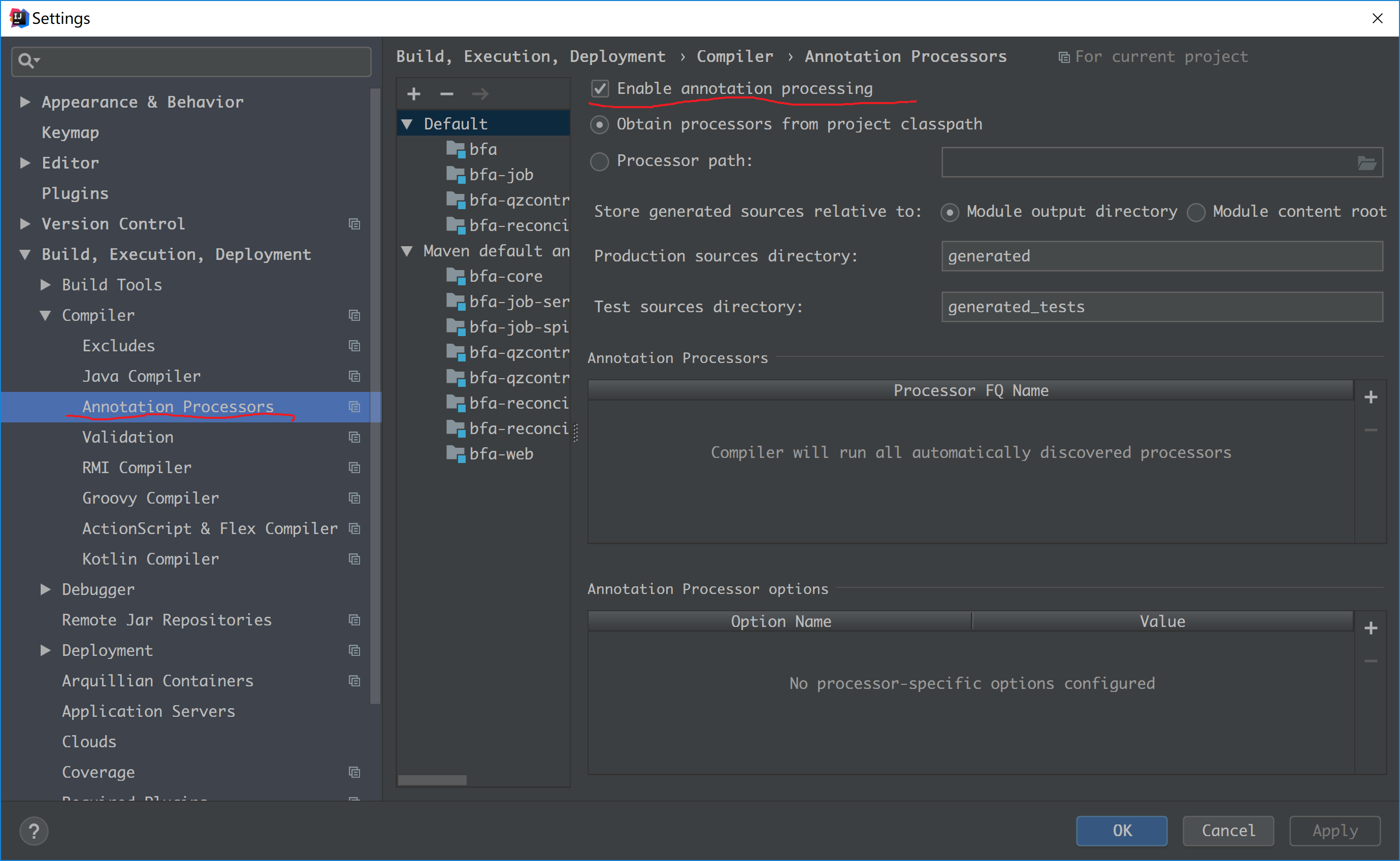Lombok插件安装与使用说明
在实习中发现项目中IDE一直报检查错误,原来是使用了Lombok注解的黑科技,这里整理了一些日常编码中能遇到的所有关于它的使用详解,其实lombok项目的产生就是为了省去我们手动创建getter和setter方法等等一些基本组件代码的麻烦,它能够在我们编译源码的时候自动帮我们生成getter和setter方法。即它最终能够达到的效果是:在源码中没有getter和setter等组件方法,但是在编译生成的字节码文件中有getter和setter等组件方法。
依赖管理
<dependency> <groupId>org.projectlombok</groupId> <artifactId>lombok</artifactId> <version>1.16.20</version> </dependency>
IDEA插件的安装
如果IDE没有安装插件的话会提示错误,而且不会有代码提示,所以IDE要安装插件
 @Data
@Data
平时在使用时最常用@Data注解
@Data可以很好地处理字段的泛型参数。 为了在为具有泛型的类构造对象时减少样板,可以使用staticConstructor参数来生成私有构造函数,以及返回新实例的静态方法。 这样,javac将推断变量名称。 因此,通过这样声明:@Data(staticConstructor =“of”)类Foo
如果使用了@Data注解
@Data public class DataExample {
private final String name;
@Setter(AccessLevel.PACKAGE) private int age;
private double score;
private String[] tags;
@ToString(includeFieldNames=true)
@Data(staticConstructor="of")
public static class Exercise<T> {
private final String name;
private final T value;
}
}
不加lombok注解的Pojo的写法
public class DataExample {
private final String name;
private int age;
private double score;
private String[] tags;
public DataExample(String name) {
this.name = name;
}
public String getName() {
return this.name;
}
void setAge(int age) {
this.age = age;
}
public int getAge() {
return this.age;
}
public void setScore(double score) {
this.score = score;
}
public double getScore() {
return this.score;
}
public String[] getTags() {
return this.tags;
}
public void setTags(String[] tags) {
this.tags = tags;
}
@Override public String toString() {
return "DataExample(" + this.getName() + ", " + this.getAge() + ", " + this.getScore() + ", " + Arrays.deepToString(this.getTags()) + ")";
}
protected boolean canEqual(Object other) {
return other instanceof DataExample;
}
@Override public boolean equals(Object o) {
if (o == this) return true;
if (!(o instanceof DataExample)) return false;
DataExample other = (DataExample) o;
if (!other.canEqual((Object)this)) return false;
if (this.getName() == null ? other.getName() != null : !this.getName().equals(other.getName())) return false;
if (this.getAge() != other.getAge()) return false;
if (Double.compare(this.getScore(), other.getScore()) != 0) return false;
if (!Arrays.deepEquals(this.getTags(), other.getTags())) return false;
return true;
}
@Override public int hashCode() {
final int PRIME = 59;
int result = 1;
final long temp1 = Double.doubleToLongBits(this.getScore());
result = (result*PRIME) + (this.getName() == null ? 43 : this.getName().hashCode());
result = (result*PRIME) + this.getAge();
result = (result*PRIME) + (int)(temp1 ^ (temp1 >>> 32));
result = (result*PRIME) + Arrays.deepHashCode(this.getTags());
return result;
}
public static class Exercise<T> {
private final String name;
private final T value;
private Exercise(String name, T value) {
this.name = name;
this.value = value;
}
//可以看到这里自动生成了of方法
public static <T> Exercise<T> of(String name, T value) {
return new Exercise<T>(name, value);
}
public String getName() {
return this.name;
}
public T getValue() {
return this.value;
}
@Override public String toString() {
return "Exercise(name=" + this.getName() + ", value=" + this.getValue() + ")";
}
protected boolean canEqual(Object other) {
return other instanceof Exercise;
}
@Override public boolean equals(Object o) {
if (o == this) return true;
if (!(o instanceof Exercise)) return false;
Exercise<?> other = (Exercise<?>) o;
if (!other.canEqual((Object)this)) return false;
if (this.getName() == null ? other.getValue() != null : !this.getName().equals(other.getName())) return false;
if (this.getValue() == null ? other.getValue() != null : !this.getValue().equals(other.getValue())) return false;
return true;
}
@Override public int hashCode() {
final int PRIME = 59;
int result = 1;
result = (result*PRIME) + (this.getName() == null ? 43 : this.getName().hashCode());
result = (result*PRIME) + (this.getValue() == null ? 43 : this.getValue().hashCode());
return result;
}
}
}
任何类定义都可以用@ToString注释,让lombok生成toString()方法的实现。默认情况下,它会按顺序打印类名以及每个字段,并以逗号分隔。
通过将includeFieldNames参数设置为true,您可以为toString()方法的输出更详细(但也有一些长度)。这是默认的
默认情况下,将打印所有非静态字段。如果要跳过某些字段,可以使用@ ToString.Exclude注释这些字段。或者,您可以使用@ToString(onlyExplicitlyIncluded = true)准确指定要使用的字段,然后使用@ ToString.Include标记要包含的每个字段。
通过将callSuper设置为true,可以将toString的超类实现的输出包含到输出中。但是java.lang.Object中toString()的默认实现几乎毫无意义,因此除非扩展另一个类,否则不要这样做。
还可以在toString中包含方法调用的输出。只能包含不带参数的实例(非静态)方法。为此,请使用@ToString.Include标记方法。
可以使用@ToString.Include(name =“some other name”)更改用于标识成员的名称,并且可以通过@ToString.Include(rank = -1)更改成员的打印顺序。没有等级的成员被认为具有等级0,更高等级的成员被首先打印,并且相同等级的成员以它们在源文件中出现的相同顺序被打印。
ToString小例子:
加注解:
@ToString
public class ToStringExample {
private static final int STATIC_VAR = 10;
private String name;
private Shape shape = new Square(5, 10);
private String[] tags;
@ToString.Exclude private int id;
public String getName() {
return this.name;
}
@ToString(callSuper=true, includeFieldNames=true)
public static class Square extends Shape {
private final int width, height;
public Square(int width, int height) {
this.width = width;
this.height = height;
}
}
}
等效于:
public class ToStringExample {
private static final int STATIC_VAR = 10;
private String name;
private Shape shape = new Square(5, 10);
private String[] tags;
private int id;
public String getName() {
return this.getName();
}
public static class Square extends Shape {
private final int width, height;
public Square(int width, int height) {
this.width = width;
this.height = height;
}
@Override public String toString() {
return "Square(super=" + super.toString() + ", width=" + this.width + ", height=" + this.height + ")";
}
}
@Override public String toString() {
return "ToStringExample(" + this.getName() + ", " + this.shape + ", " + Arrays.deepToString(this.tags) + ")";
}
}
@NoArgsConstructor
此注释主要与@Data或生成注释的其他构造函数组合使用。
@NoArgsConstructor将生成一个没有参数的构造函数。如果这是不可能的(因为最终字段),将导致编译器错误,除非使用@NoArgsConstructor(force = true),然后使用0 / false / null初始化所有final字段。对于具有约束的字段,例如@NonNull字段,不会生成任何检查,因此请注意,在稍后正确初始化这些字段之前,通常不会满足这些约束。某些java构造(例如hibernate和Service Provider Interface)需要no-args构造函数。
@RequiredArgsConstructor
@RequiredArgsConstructor为每个需要特殊处理的字段生成一个带有1个参数的构造函数。所有未初始化的final字段都会获得一个参数,以及标记为@NonNull的任何字段,这些字段在声明它们时未初始化。对于标有@NonNull的字段,还会生成显式空检查。如果用于标记为@NonNull的字段的任何参数包含null,则构造函数将抛出NullPointerException。参数的顺序与字段在类中的显示顺序相匹配。
@AllArgsConstructor
@AllArgsConstructor为类中的每个字段生成一个带有1个参数的构造函数。标有@NonNull的字段会导致对这些参数进行空检查。
这些注释中的每一个都允许使用替代形式,其中生成的构造函数始终是私有的,并且生成包围私有构造函数的附加静态工厂方法。通过为注释提供staticName值来启用此模式,如下所示:@RequiredArgsConstructor(staticName =“of”)。与普通构造函数不同,这种静态工厂方法将推断泛型。这意味着您的API用户可以编写MapEntry.of(“foo”,5)而不是更长的新MapEntry <String,Integer>(“foo”,5)。
与大多数其他lombok注释不同,显式构造函数的存在不会阻止这些注解生成自己的构造函数。这意味着可以编写自己的专用构造函数,并让lombok生成样板文件。
注意:如果出现冲突(自定义的一个构造函数最终使用与lombok生成的构造函数相同),则会发生编译器错误。
就是简化了生成log的代码,直接看例子
@Log
public class LogExample {
public static void main(String... args) {
log.severe("Something's wrong here");
}
}
@Slf4j
public class LogExampleOther {
public static void main(String... args) {
log.error("Something else is wrong here");
}
}
@CommonsLog(topic="CounterLog")
public class LogExampleCategory {
public static void main(String... args) {
log.error("Calling the 'CounterLog' with a message");
}
}
等效于:
public class LogExample {
private static final java.util.logging.Logger log = java.util.logging.Logger.getLogger(LogExample.class.getName());
public static void main(String... args) {
log.severe("Something's wrong here");
}
}
public class LogExampleOther {
private static final org.slf4j.Logger log = org.slf4j.LoggerFactory.getLogger(LogExampleOther.class);
public static void main(String... args) {
log.error("Something else is wrong here");
}
}
public class LogExampleCategory {
private static final org.apache.commons.logging.Log log = org.apache.commons.logging.LogFactory.getLog("CounterLog");
public static void main(String... args) {
log.error("Calling the 'CounterLog' with a message");
}
}
想要更详细的了解Lombok,推荐查看它的github来阅读更多的使用特性
Lombok的gitHub链接
以上就是本文的全部内容,希望对大家的学习有所帮助,也希望大家多多支持亿速云。
免责声明:本站发布的内容(图片、视频和文字)以原创、转载和分享为主,文章观点不代表本网站立场,如果涉及侵权请联系站长邮箱:is@yisu.com进行举报,并提供相关证据,一经查实,将立刻删除涉嫌侵权内容。